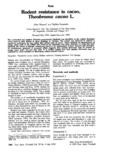| dc.contributor.author | Warren , J. | |
| dc.contributor.author | Emamdie, D. | |
| dc.date.accessioned | 2014-10-18T03:14:56Z | |
| dc.date.available | 2014-10-18T03:14:56Z | |
| dc.date.issued | 1993 | es_ES |
| dc.identifier | 370551 | es_ES |
| dc.identifier.uri | https://repositorio.catie.ac.cr/handle/11554/3917 | |
| dc.description | 1 fig. 1 tab. | es_ES |
| dc.description.abstract | The neotropical red squirrel (Sciurus granatensis Humboldt) was identified as the rodent damaging cacao pods in field studies in three locations in Trinidad. The rodent was observed to express a significant preference for ripe rather than unripe pods of cacao. Clonal variation in attractiveness of unripe cacao pods to the rodent was found to be consistent over sites. However, in pods that were attacked, the extent of damage caused was found to be independent of both ripeness and accession. An evolutionary argument is proposed which suggests that gazing deterrents may be present in unripe cacao pods, but not ripe ones. It is further argued that such gazing derrents may be exploited by cacao breeders in developing rodent-resistant clones. | en_US |
| dc.language.iso | en | es_ES |
| dc.publisher | University of the West Indies, St. Augustine (Trinidad y Tobago) | es_ES |
| dc.rights | info:eu-repo/semantics/openAccess | es_ES |
| dc.subject | THEOBROMA CACAO | es_ES |
| dc.subject | RODENTIA | es_ES |
| dc.subject | PLAGAS DE PLANTAS | es_ES |
| dc.subject | DAÑOS | es_ES |
| dc.subject | CULTIVO | es_ES |
| dc.subject | FENOLOGIA | es_ES |
| dc.subject | RESISTENCIA A LAS PLAGAS | es_ES |
| dc.title | Rodent resistance in cacao, Theobroma cacao L. | es_ES |
| dc.type | Artículo | es_ES |


